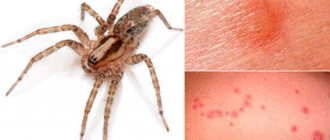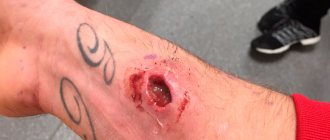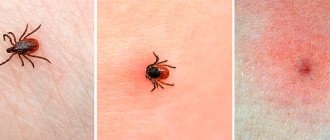Consequences
Ticks become active during the first spring warmings. In the south of Russia this is the end of February, in the middle zone and in the north - April-May. In the heat, the parasites lose activity, but with the first autumn rains they resume.
Ixodid tick
How dangerous is a tick bite for a dog?
Eggs require animal protein to mature. Ixodid ticks have adapted to obtain it from the blood of mammals. The parasites attach themselves to the animal’s skin and secrete painkillers so that the dog does not notice the presence of guests. To prevent blood clotting, the parasite secretes anticoagulants.
How long does a tick live on a dog? The parasite needs time to choose a secluded place, attach to the skin, make a puncture and suck on. Most often, the tick is attached to the folds of the skin or ears. The female is saturated with blood for 6 days and increases in size a hundred times. In total, the parasite can live on a pet for up to 10 days.
If a dog has a lot of ticks attached to it, anemia develops. The pet weakens, becomes defenseless against the permanent inhabitants of the skin - coccus bacteria, and develops dermatitis and abscesses. The main danger to animals and humans are sexually mature individuals, mainly females, who carry pathogens.
Ixodid ticks prefer secluded places
It is dangerous for the parasite to get inside. If a dog accidentally swallows a tick, it will dissolve and pathogens will enter the bloodstream.
What diseases can ticks transmit to dogs?
The following infectious diseases pose the greatest danger:
- Piroplasmosis (babesiosis). Caused by protozoan microorganisms that settle inside red blood cells.
- Bartonellosis is caused by motile bacteria that parasitize red blood cells.
- Borreliosis or Lyme disease is caused by spirochetes.
- Ehrlichiosis is caused by protozoan microorganisms.
Ixodid ticks are dangerous not only for dogs. In the steppe regions, through the bites of arthropods, people become infected with Crimean fever, and residents of the taiga become infected with tick-borne encephalitis.
Can a dog die?
If you find a tick on your dog, don't panic. Not every parasite is infected. In addition, the arthropod needs time for protozoan microbes or pathogenic bacteria to move from the intestines to the salivary glands.
However, if you missed the moment of tick attachment and find it already sucking blood, consult a doctor.
If the arthropod is infected with Babesia, the dog may die.
When infected with other pathogens, recovery is possible, but death cannot be ruled out after a long illness.
The tick sucked blood
Tick-borne encephalitis in dogs - causes
Speaking about the causes of various diseases, we should highlight the importance of this link in preventing the occurrence of the disease. Knowing the reasons, the owner must make every effort to prevent the inclusion of factors influencing the development of the disease. Tick-borne encephalitis in dogs is caused primarily by the influence of microelements, namely viral cells that are injected by the ixodid tick when biting an animal.
- In addition to the tick bite, there is also causesaccording to which your the dog may become subject to encephalitis. These include:
- infections typical of dogs (parvovirus, plague, etc.);
- various mycoses;
- with inflammation of the inner ear, complications may occur that provoke the development of encephalitis;
- a foreign body in the dog’s body that has entered through the esophagus.
Tick-borne encephalitis in dogs: which breeds are more susceptible to infection?
Speaking about the characteristics of the disease, it should be mentioned that due to genetic characteristics, the risk of infection may increase and decrease depending on the breed of your pet
. The risk group includes:
- dogs under 2 years of age. The immune system is not yet strong enough and may be due to the misfortunes of various diseases, not only encephalitis;
- dogs that are mature, from 8 years old. This is due largely to decreased immunity;
- certain breeds of dogs - poodle, decorative terriers, pug, German shorthaired pointers, Maltese, beagle. All of the listed breeds, to one degree or another, belong to medium and small breeds. But despite this, cases of infection of dogs of larger families are often recorded;
- animals that have suffered cranial trauma.
There are different types of tick-borne encephalitis in dogs
Encephalitis may vary by type . These species are characterized by differences in the affected areas of the animal’s body.
.
- Let's look at these classification of encephalitisin details:
- Meningoencephalitis - for this type, damage to the brain and all its membranes is determined;
- Encephalomyelitis - in this case, the brain and spinal cord are affected simultaneously;
- Meningoencephalitis - affects the membranes of the brain and spinal cord.
Encephalitis affects the most important organs responsible for the normal functioning of the animal. It is very important to begin treatment of the disease in the early stages.
This will help avoid a bad course of the disease.
Tick-borne encephalitis in dogs and its symptoms
Knowing the symptoms of the disease , the owner has the opportunity to quickly respond to the first manifestations of the disease and seek help as quickly as possible. Signs of encephalitis should never be ignored
, and even more so engage in self-diagnosis and self-medication. This can have a very bad effect on your pet's health. Emerging complications can give rise to the formation of new pathologies, even death.
Symptoms that can be observed with tick-borne encephalitis can be misleading to the pet owner. The manifestations of the disease are characterized by their appearance 12-24 hours after the bite
. They are observed for the next one or two days, after which they may fade away. This is where the biggest danger lies. A slight one-day illness in a dog can be perceived as a cold or a change in weather conditions, in general, something insignificant. But, in the absence of the necessary treatment, it will only get worse.
- Let's look at what you need to pay attention to when talking about the signs of tick-borne encephalitis:
- decreased appetite, up to its complete loss;
- weakness of the limbs - there may be a change in gait, the dog does not seem to stand firmly on its hind legs;
- color of urine during bowel movements - the color of urine can vary from brown to dark green;
- sclera color - they acquire a pale or yellow tint;
- disruption of the gastrointestinal tract - possible diarrhea with streaks of blood in the stool;
- gagging.
If there is the slightest sign of encephalitis, you should immediately seek help from a veterinarian
.
If the disease is detected in the early stages, treatment will last a couple of days, after which maintenance therapy is necessary. If you start treatment, a severe form of encephalitis occurs, which is cured in 75 out of 100 cases. But to completely get rid of the disease, it may take up to 20 days of active treatment
.
Diagnosis of tick-borne encephalitis in dogs
Before the veterinarian prescribes treatment, the body must be diagnosed . It is necessary to determine the type of encephalitis , the stage of the disease and other factors that influence the course of treatment. Diagnosis is based on carrying out a certain kind of measures (research) that make it possible to establish the exact reason for contacting the veterinary center. The professionalism of the doctor can be a key factor. Since encephalitis can have similar symptoms to other diseases, an error in making a diagnosis is not acceptable.
- Below are the main types of examinations to determine tick-borne encephalitis in dogs:
- initial examination by a veterinarian - the doctor must visually examine the patient. Upon examination, a tick may be noticed that needs to be removed;
- blood and urine tests are basic tests that reflect the general condition of the body and can help identify abnormalities in the functioning of certain organs;
- radiography - this type of study is carried out to detect cerebral edema and head injuries;
- ultrasound examination - the internal organs of the animal are examined;
- electroencephalography - this type of examination focuses on studying the extent and areas of damage to the pet’s nervous system;
- cerebrospinal fluid examination - since infectious encephalitis can affect the organs of the brain and spinal cord, it is necessary to conduct an appropriate examination.
The very first thing that needs to be applied to a dog, regardless of whether it is diagnosis or treatment, is to find the cause on the animal’s body
, in our case, this is a tick.
Symptoms and signs
Babesia
1. The incubation period for piroplasmosis is from 1 to 3 weeks. Babesia settle in red blood cells and feed on their contents. When they have eaten everything, they move to the next cage.
The following forms of the disease are distinguished:
- Lightning fast, the animal dies suddenly without clinical symptoms.
- Manifest, characterized by the following signs: after a tick bite, the dog experiences convulsions;
- refusal to eat;
- yellowness of mucous membranes;
- temperature 42°C;
- tachycardia;
- dark brown urine;
- paralysis of the hind limbs.
2. Bartonellosis is characterized by a chronic course. Months after the bite, the following symptoms develop:
- vomiting, diarrhea;
- conjunctivitis;
- myocarditis;
- pathologies of the mucous membranes - rhinitis, stomatitis; gingivitis.
3. Borreliosis develops 3-4 weeks after the bite. The disease is characterized by the following symptoms:
- lameness, joint pain;
- fever;
- tachycardia;
- paresis of limbs;
- convulsions;
- a characteristic symptom is ring-shaped redness after a bite or erythema migrans, which disappears and appears on another part of the body.
4. Ehrlichiosis is characterized by inflammation of blood vessels - vasculitis. Clinical signs are as follows:
- apathy;
- hyperthermia - 41° C;
- purulent rhinitis and conjunctivitis;
- hemorrhages on mucous membranes and non-pigmented skin;
- thrombocytopenia.
Watch the video:
What to do
To save a dog after a bite, you need to provide first aid, remove the tick, place it in a bottle and take it to the clinic. There they will conduct a study to detect the DNA of pathogens and prescribe treatment.
If the tick turns out to be free of contagion, observe the dog and remember that pathological symptoms may appear several months after the bite.
First aid for a bite at home
If you find a tick, it must be safely removed.
Don’t panic, even if the arthropod is infected, it takes a day or more for the pathogens to reach the salivary glands of the parasite.
However, one cannot be careless. There may be microorganisms inside the tick that can cause human illness. When crushed, protozoa or bacteria can enter the bloodstream through mucous membranes or skin pores. Therefore, wear gloves.
The opinion that a tick can be killed by lubricating the spiracles with oil is unfounded. The arthropod can live without oxygen for more than a day. During this time, pathogens will enter the bloodstream. Applying an insecticide to the parasite does not always help. The tick will not die soon, but the dog will have time to become infected.
Do not remove an attached parasite with tweezers.
If limbs or the head remain in the wound after a bite, inflammation will develop.
Use professional tick removers.
I tried to pull out the tick with Anti-Tick tweezers. I did not like. The inflated parasite burst, blood sprayed out, it’s good that he dodged and didn’t get a jet in his eyes.
Anti-mite
Perhaps this is my subjective opinion. But Tik Twister delighted me. I turned the tick out the first time.
Tick Twister
The device resembles a nail puller and costs about 160 rubles. Watch the video and rate.
Recommended reading:
How to remove a tick from a dog?
If you removed the parasite carelessly, after the tick bite a lump may form that is dense and painless to the touch.
Most often, the tumor does not cause harm and is an allergic response to the secretions left by the arthropod. Perhaps the affected area was itchy and the pet scratched it. But the red spot spoils the appearance and can remain at the site of the bite for up to six months.
In any case, observe your pet for 15-20 days. If the dog's behavior has not changed, the mucous membranes have not turned pale or yellowed, it eats well, is active and cheerful, everything is fine.
If a tick leg remains in the wound , the formation will gradually resolve. But when the head remains, there is a high probability of suppuration and the formation of an abscess. Do not fix the defect yourself. You may cause skin irritation that may result in eczema or another type of dermatitis that is difficult to treat. Visit a veterinary hospital and take the medicine prescribed by your doctor.
When you find a dead tick on your dog , pay attention to its size. If it has sucked blood, then take the parasite to a hospital for examination to determine what contagions are inside it. If the arthropod is small, test anyway. You may have used acaricides that killed the parasite. Or the dog snapped his teeth and crushed the arthropod. But there is no guarantee that other ticks will also die. Therefore, it is better to know whether he is infected or not?
I foresee questions about what to do when you are in the forest, at the dacha, there are no veterinary clinics around, and a tick has bitten your dog? Responsible dog breeders, before going into nature, go to a hospital so that the pet can be given an antiprotozoal drug, for example, Piro-Stop, for preventive purposes.
The veterinary industry produces antiprotozoal drugs that are used to kill Babesia after a tick bite based on imidocarb or diminazene aceturate.
Imidocarb derivatives - Piro-Stop, Forticarb, Babezan are produced in solution, are relatively harmless and high in cost (a 10 ml bottle of Piro-Stop - 524 rubles). After opening the container, the medicine must be developed within 28 days.
Medicines based on diminazene aceturate - Azidine, Berenil, Veriben, Pirosan - are produced in powders that are dissolved before use. The drugs are effective and inexpensive (2.4 g of Azidine sells for 30 rubles), but have side effects.
If you risk using the drugs yourself, there is a high probability that you will save the dog, but make it disabled. On the Internet you will definitely run into advice from amateurs like yourself. Therefore, contact your veterinarian by phone and follow his instructions.
Tick season is open, be careful
In addition to studying potentially dangerous areas, other measures will help you prepare for the season and protect yourself from ticks.
- Collect and take with you to the outdoors a first aid kit for a bite: a tick remover, a disinfectant and a container for submitting the tick to the laboratory, for example, a jar for medical tests.
- Write down in advance the addresses and telephone numbers of the medical institutions closest to your vacation spot, where they will help you remove the tick and provide first aid.
- Get vaccinated against tick-borne encephalitis.
- Use repellents and acaricides that can be applied to clothing and skin.
- If you go foraging for mushrooms or hiking, wear clothing that is as closed as possible, making sure that insects have a minimum chance of getting under it and getting to your body.
- If you are relaxing at the dacha, order the treatment of the entire area from ticks at a SES certified by Rospotrebnadzor
. - Regularly mow the lawn at your dacha and take care of the garden; this will not get rid of ticks completely, but it will help prevent their numbers from increasing and will reduce the likelihood of a bite.
Tick season is open, be careful and combine various measures at your discretion depending on the situation. Spending a little time and money in advance to prevent problems associated with ticks is easier than panicking and trying to find a way out after a bite and infection have already occurred.
Treatment
The professional approach to the treatment of piroplasmosis in the Russian Federation and abroad is different.
The European approach is to inject an imidocarb-based drug if symptoms of piroplasmosis occur. The dog is monitored for 2 weeks. If your pet is feeling good, there is no need to do anything. Otherwise, the injection is repeated. Imidocarb protects the dog from subsequent arthropod attacks.
If the first injection coincides with darkening of the urine, an antimicrobial drug containing Doxycycline, Azithromycin or erythromycin is prescribed. Antibiotics destroy synergistic microflora. After completing the course, the dog is temporarily transferred to veterinary food with prebiotics to restore digestion.
In Russia, a different treatment regimen has been adopted. Diminazene aceturate derivatives are mainly used. To maintain the function of the liver, kidneys, and heart, maintenance therapy is carried out through droppers. Antibiotics are widely used. Veterinarians practice additional injections of antiprotozoal drugs. The liver suffers. The situation is corrected with hepatoprotectors.
I recommend using Hill's l/d high-calorie and low-protein veterinary nutrition for the treatment of liver pathologies to restore digestive functions.
Despite the dissimilarity of symptoms and pathogens, the treatment regimen for bartonellosis, borreliosis and ehrlichiosis is approximately the same. In all situations, a course of antibiotic therapy with Doxycycline is used.
If the causative agent of the disease is protozoan microorganisms, an injection of Imidocarb is given. General strengthening agents, hepatoprotectors, and B vitamins are used.
To restore digestive functions, use Hill's l/d or Royal Canin Hepatic medicinal food.











